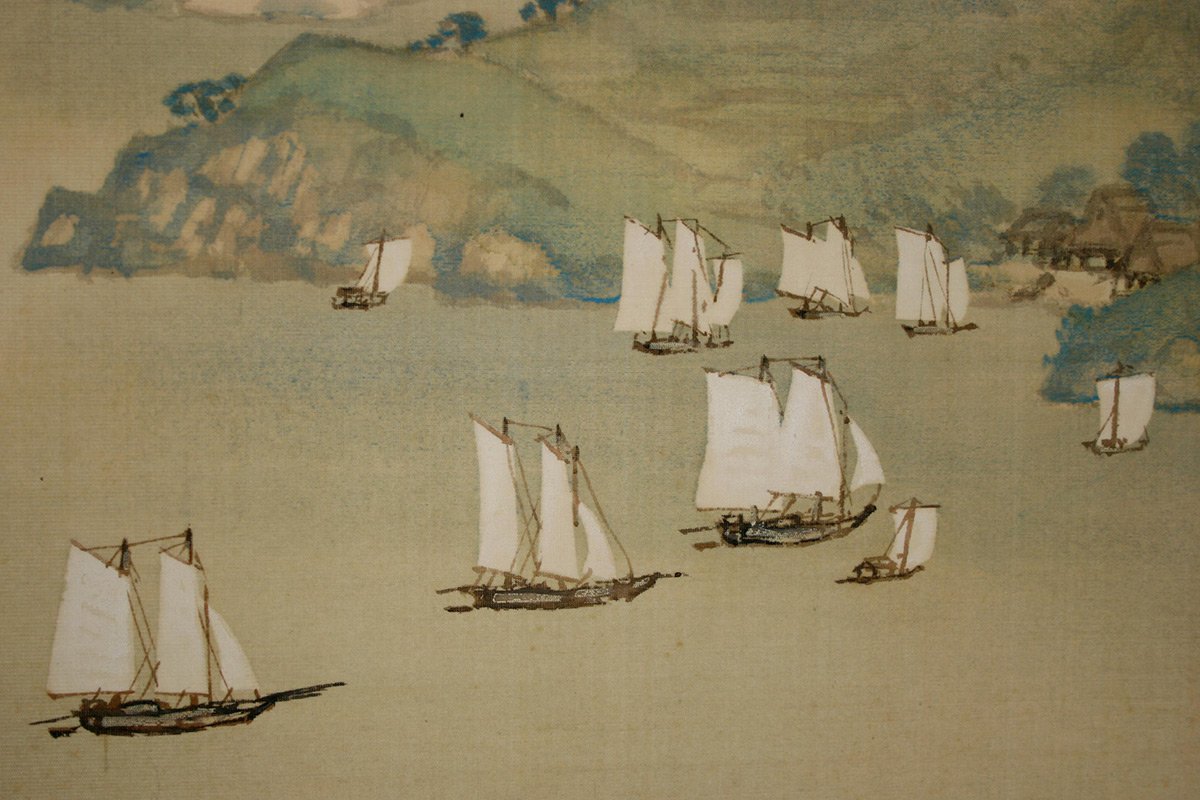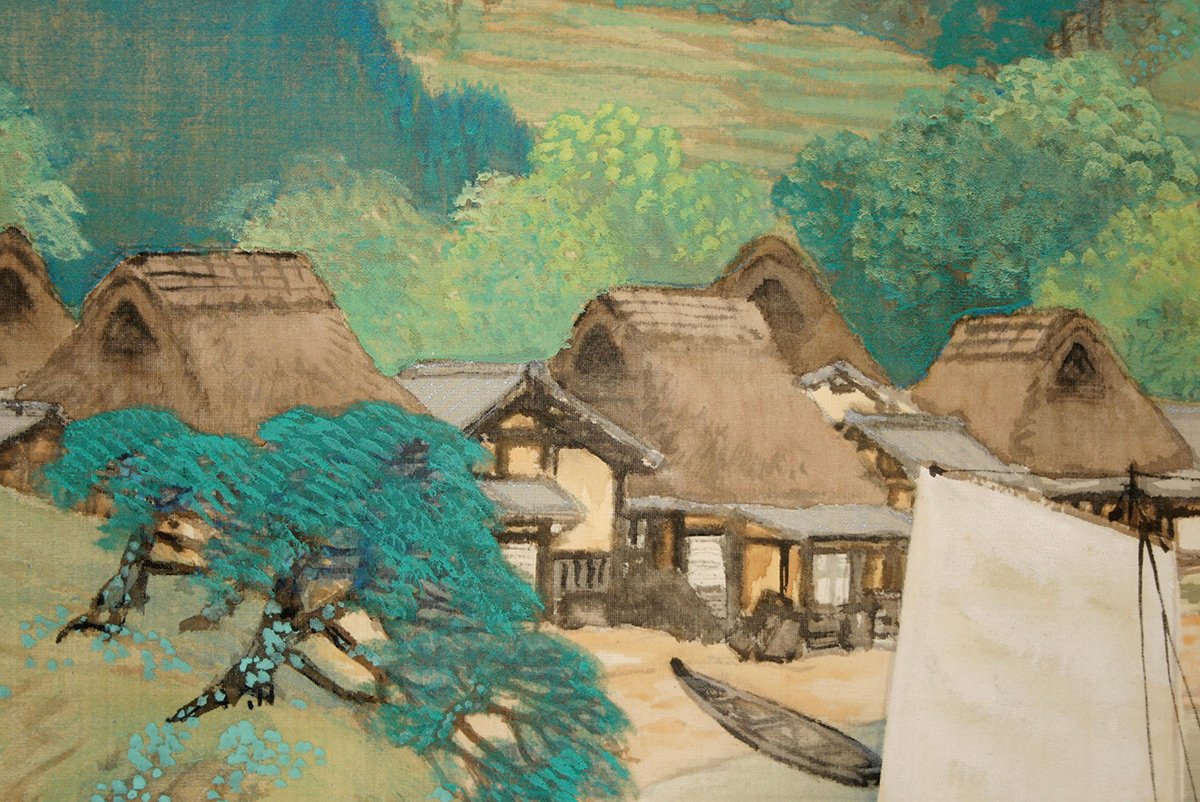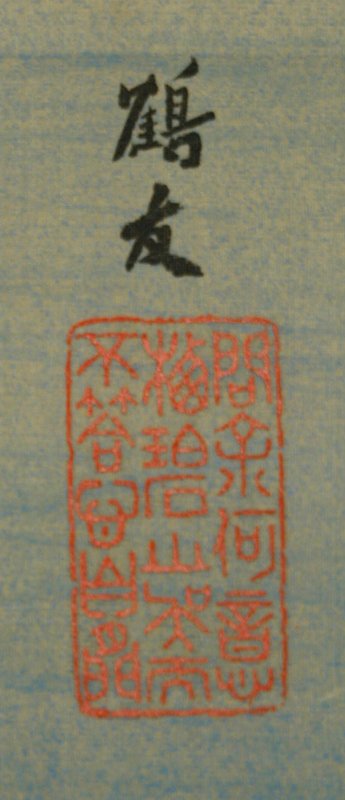PAINTINGS & SCREENS
SHODA KAKUYU, 1926 EXHIBITION PAINTING OF THE BOATS ON THE INLAND SEA
Painting on silk in mineral pigments, gofun or powdered clam shell, and sumi ink mounted as a hanging scroll, depicting a summer scene of a fleet of sail boats fishing among islands in the Inland Sea. Signed on the lower right by the artist: Kakuyu, and sealed* (see note below) (Shoda Kakuyu, the go or art name of Shoda Tsuneyoshi, 1879 – 1948). Taisho 15 or 1926.
Note: the seal on the painting quotes two lines from the Tang Dynasty poet Li Po’s poem:
Mid Mountain: Question and Answer (Title of Poem)
*You ask me why I dwell on Emerald Mountain.
*I laugh, without answering, my heart at ease.
Peach flowers in the water’s current linger into vanishing.
Heaven and earth are different here than in the world of men.
(Translation by Andrew Haley)
With the double tomobako or original box, inscribed on the exterior of inner box’s lid: Rento Hakuhan Zu or Aligned Islands and White Sails; and on the reverse of the lid signed: Kakuyu Dai or Titled by Kakuyu, and sealed: Kakuyu.
Enclosed in the box is a letter dated to September 13th of Showa 17 or 1942, from Hasegawa Fukuhei to Shoda Kakuyu’s assistant requesting help in borrowing this painting from its owners in Hiroshima, in order to use it as the cover illustration for a book he has written.
This painting is listed in the catalogue for the 6th exhibition of the Nihon Jiyu Gakai or Japan Independent Painting Group, held in Taisho 15 or 1926.
Shoda Kakuyu was born in Nara Prefecture. In 1885, his family moved to Kyoto and in 1898, he graduated from the Painting Department of the Kyoto Municipal School of Art. Soon afterwards he became a student of Yamamoto Shunkyo. His art studies were interrupted the following year by induction into the Imperial Japanese Army’s engineering corps, in which he served from 1899 – 1902. Upon being discharged from the army, Kakuyu immediately returned to painting. With Shunkyo’s encouragement, he submitted a large landscape painting to the 5th Domestic Industrial Exposition, and the piece won an award. When the Russo-Japanese War broke out, Kakuyu was reconscripted into the army from 1904 – 1906. Following his second discharge he returned to Kyoto, and one of his paintings was accepted for exhibition at the 1st Bunten in 1907. In 1908, he married Shunkyo’s niece. Subsequently Kakuyu was accepted at many Bunten, winning awards in 1910 – 1912 and in 1914 – 1915. He then became an assistant instructor and later professor at the Kyoto City Special Painting School. Through the 1920s Kakuyu withdrew from the official exhibitions and instead showed with Shunkyo’s Sanekai group and the Nihon Jiyu Gadan or Japan Independent Painting Group. In 1933, he returned to the official venues with this painting at the 14th Teiten, with the status of a suisen or nominated artist. He participated in the Bunten Kansaten in 1936, and from 1938 in the Shin-Bunten with mukansa or non-vetted artist status. After the Pacific War, Kakuyu suffered from increasingly ill health and died in Kyoto in 1948.
Kakuyu’s work is appreciated for his tremendous technique. His brushwork and coloration were similar to that of his teacher, Yamamoto Shunkyo, and the continuing focus of his work was on an idealized imagery of mountain vistas, spectacular waterfalls and river gorges.
For another of Kakuyu’s exhibition paintings, c.f. Kagedo’s catalogue Light Through Clouds, number 55.
The 1920s saw the rise of a deep emotional bond between many city dwellers and the idyllic countryside they associated with a disappearing world. This nostalgic feeling entered into the new Mingei or Folk Art Movement, and colored the work of many artists who longed for a simpler and more beautiful life. It entered into the idiom of artists working in ceramics, woodblocks, painting, textiles, and metalwork. The same years shared the industrial design and starkly modernist aesthetic of the young Mukei group, which sought to return craftsmanship and art to the level of everyday use. All of these may be responses to increasing urbanization and the complexity of modern life, or a simpler golden age may be something of which we have always dreamed.
The painter was perfectly fluent with the classical tradition of Japanese and Chinese painting. He also read Chinese poetry, as the seal quote from the Tang poet Li Po makes clear. While elements of these echo in his work, Shoda Kakuyu offers his own vision of landscape as an epiphany or revelation of life’s grandeur and beauty.
Kakuyu paints an idealized, summer seascape of green islands receding towards cloud-misted mountains. In the foreground, sunlight dances over blue, rippling waves and a fleet of traditional fishing craft crowd the waters with white sails. Between verdant hills and the sand of a beach nestle the thatched roofs of a small village. Opposite, a rocky cliff edged with pines borders the narrow strait. In the distance, sheltering isles frame a wide bay strewn with diminishing sails and the pale reflections of clouds.
Shoda Kakuyu, 1926 Exhibition Painting of the Boats on the Inland Sea
Artist Name: Shoda Kakuyu
Period: Meiji Taisho
Mediums: Mineral Pigments
Form: Scroll
Origin Country: Japan
83 ½” high x 35 ¼” wide, inclusive of mounting
60 7/8” high x 27 7/8” wide, painting dimension
This piece is no longer available.






